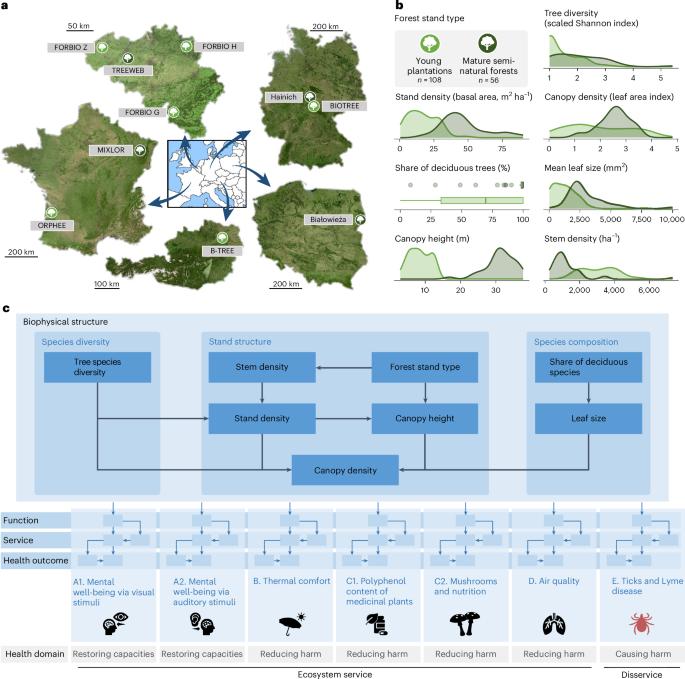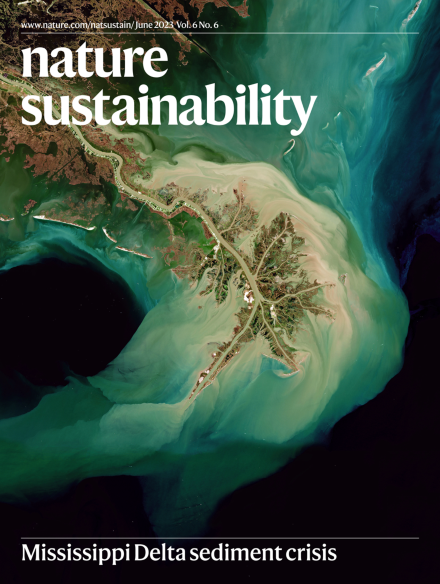Forest biodiversity and structure modulate human health benefits and risks
IF 27.1
1区 环境科学与生态学
Q1 ENVIRONMENTAL SCIENCES
引用次数: 0
Abstract
The benefits and risks of forests to human health are widely recognized. Yet, variation across forest types and their ecological characteristics driving health effects remain underexplored. Based on a continental-scale, interdisciplinary empirical database from 164 European forest stands, we constructed a Bayesian Belief Network to quantify seven causal pathways relating distinct forest types to physical and mental health. These forest–health pathways included mental well-being via visual or auditory stimuli, thermal comfort, polyphenol content of medicinal plants, mushrooms and nutrition, air quality, and ticks and Lyme disease. Results show that forests consistently provide net health benefits regardless of their ecological characteristics. Forest canopy density and tree species diversity emerge as key drivers, but their effect size and directionality are strongly pathway-dependent. Changes in forest canopy density can generate trade-offs. For example, forests optimized for heat buffering and air pollution mitigation may compromise medicinal plant yield and enhance Lyme disease prevalence. Tree diversity effects were weaker but more uniformly positive. Therefore, forest management should account for such trade-offs to tailor forest biodiversity and functioning to local public health priorities. The benefits and risks of nature to human health have been studied, however, robust empirical research on forest biodiversity and health outcomes is still lacking. Here the authors use a unique dataset from 164 European forest stands to explore the associations between forest types and well-being.

森林生物多样性和结构调节人类健康的利益和风险
森林对人类健康的益处和风险已得到广泛认识。然而,森林类型之间的差异及其生态特征对健康影响的影响仍未得到充分探索。基于来自164个欧洲森林林分的大陆尺度跨学科经验数据库,我们构建了贝叶斯信念网络,以量化不同森林类型与身心健康之间的7条因果通路。这些森林健康途径包括通过视觉或听觉刺激的心理健康、热舒适、药用植物、蘑菇和营养的多酚含量、空气质量、蜱虫和莱姆病。结果表明,无论其生态特征如何,森林始终提供净健康效益。森林冠层密度和树种多样性是主要驱动因素,但其效应大小和方向性具有强烈的路径依赖性。森林冠层密度的变化可以产生权衡。例如,为热缓冲和缓解空气污染而优化的森林可能会损害药用植物的产量,并增加莱姆病的发病率。树木多样性效应较弱,但更一致为正。因此,森林管理应考虑到这种权衡,使森林生物多样性和功能适应当地公共卫生优先事项。已经研究了自然对人类健康的惠益和风险,但是,仍然缺乏关于森林生物多样性和健康结果的强有力的实证研究。在这里,作者使用来自164个欧洲森林的独特数据集来探索森林类型与福祉之间的关系。
本文章由计算机程序翻译,如有差异,请以英文原文为准。
求助全文
约1分钟内获得全文
求助全文
来源期刊

Nature Sustainability
Energy-Renewable Energy, Sustainability and the Environment
CiteScore
41.90
自引率
1.10%
发文量
159
期刊介绍:
Nature Sustainability aims to facilitate cross-disciplinary dialogues and bring together research fields that contribute to understanding how we organize our lives in a finite world and the impacts of our actions.
Nature Sustainability will not only publish fundamental research but also significant investigations into policies and solutions for ensuring human well-being now and in the future.Its ultimate goal is to address the greatest challenges of our time.
 求助内容:
求助内容: 应助结果提醒方式:
应助结果提醒方式:


